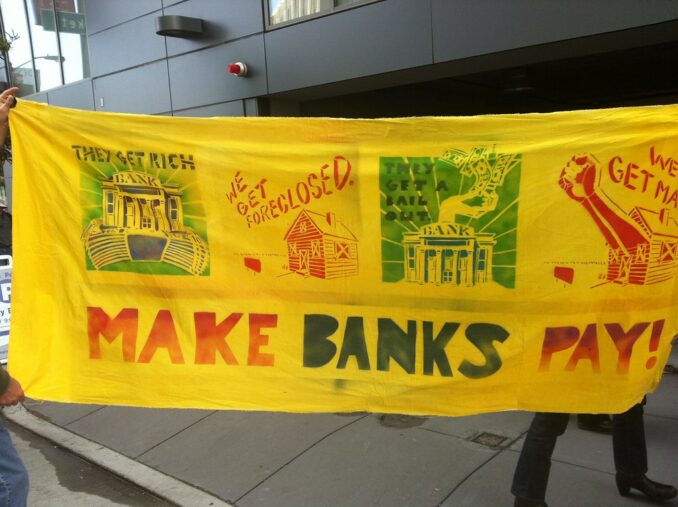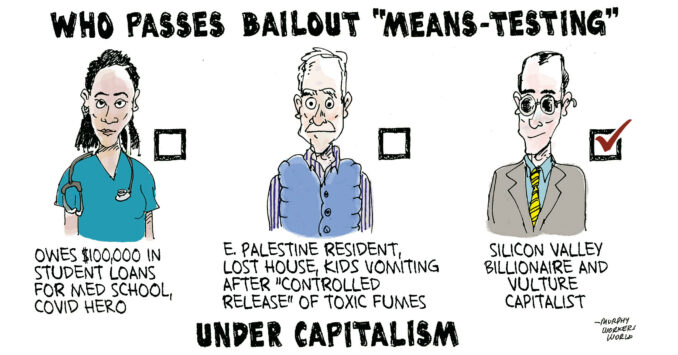The banking crisis: Will it push the working class or fascism to rise up?
WW commentary
The capitalist ruling class is worried that the banking crisis, which began less than a month ago with the collapse of the Silicon Valley Bank and quickly spread, could ultimately mushroom into a global financial crisis bigger than the crash of 2008. All talk of a “soft landing” has ended. The tech industry, a pillar of U.S. capitalism for a long time, is teetering on the edge of the cliff, and so is the commercial housing market.

Despite the emergency around-the-clock efforts by the White House, the Federal Reserve, the Treasury Department and Wall Street to bail out the banks and prevent contagion, runs on mid-level banks have spread across the U.S. and around the world. High on the growing list of fears for the capitalist system is that this new crisis, which has already choked off lending and exposed the magnitude of the systemic debt crisis, will bring bank lending to a virtual halt, exacerbating the dreaded “liquidity” crisis.
When that happens, the dominoes begin falling even faster, and a global collapse of the financial system and a worldwide economic superstorm become harder and harder to avoid. The contradiction is that the capitalists themselves lit the fire that morphed into this new bank crisis by raising interest rates, in order to bring the economy to a halt. The central bankers were following the old playbook.
When the economic system is descending into deeper crisis and threatens profit-making, the solution throughout the history of capitalism has been to slow or even stop the economy, throw tens of millions of workers out of their jobs and attack the workers and the oppressed in a thousand ways, until the system is returned to profitability. The problem now with the save-capitalism playbook is that the capitalists can’t stop or control the fire that they’ve started and the slide toward unprecedented catastrophe.
What must revolutionaries do?
Discussing the dimensions of the banking crisis and where it’s headed is essential, but it’s not enough. It is vital that revolutionaries, socialists and communists understand and respond to the dangerous political crisis that all of this creates for the working class. Either the working class and oppressed and their organizations and movements turn this crisis into an opportunity to get organized — rising up and breathing life into a militant, massive, class struggle against capitalism — or the neofascist forces will fill the vacuum, build up their strength and open up an all-out war on the working class.
Lest we forget, it was the near collapse of the capitalist financial system in 2008, the bailout of Wall Street and the “Great Recession” that paved the way for the rise of Trump and a fascist movement that has engaged in violent attacks on the most oppressed.

In the aftermath of 2008, the labor movement as well as other progressive movements, with some notable exceptions, were held in check by the Democratic Party. Stopping the working class from rising up, breaking with capitalism and doing what is necessary to come into its own as a social force, conscious of itself as a class, is the primary purpose of the Democratic Party. We must, by all means necessary, avoid a repeat of the post 2008 political trap that stopped the working class from rising up.
The good news is that, over the last two years, we have seen the beginnings of a young worker rebellion that holds the potential of pushing the working class forward to a higher level or organization and class struggle. Starbucks workers, Amazon workers and countless other workers at chain stores, hospitals, factories and tech companies, along with gig workers and migrant workers, have created the biggest opening for mass revolutionary progress in the working class in almost a century.
The labor movement has noted this development and offered it some support. But that support is a drop in the bucket when it comes to stopping one of the biggest union-busting wars in recent history, led by the corporate leaders of Amazon and Starbucks.
Unions must break with the Democrats
Some interesting things are happening in the labor movement. Older unions like the Teamsters and the UAW are undergoing rank and file-based change. But corporate, top-down unionism that is tied to the Democratic Party is still the norm. It’s time to open up a new political struggle inside the labor movement, a struggle that brings in the energy and militancy of the young workers, who are on the move.
We have watched the French workers strike and take to the streets by the millions to stop Macron’s and the French bourgeoisie’s attack on their hard-won rights. We have to ask: Why hasn’t the U.S. labor movement organized a protest in front of the French mission to the United Nations to show their support for the French workers? U.S. workers could learn a lot from the French workers, and that is how it should be. After all, we are in the same class, a global class that should recognize no boundaries.
Last summer Liz Shuler became the president of the AFL-CIO. Probably the overwhelming majority of workers who are not in unions, or even many who are in unions, don’t even know her name. It’s likely that more workers have heard of Chris Smalls, the president of the Amazon Labor Union, who won the first union victory against the transnational behemoth, which in many ways is the most powerful capitalist corporation in the world.
Why is it that the labor movement has not called a major, serious march on Amazon or Starbucks, in support of the workers and against union busting? This has to change, and we must understand that it is our duty as revolutionary fighters for the working class to find the ways to become the agents of that change.

